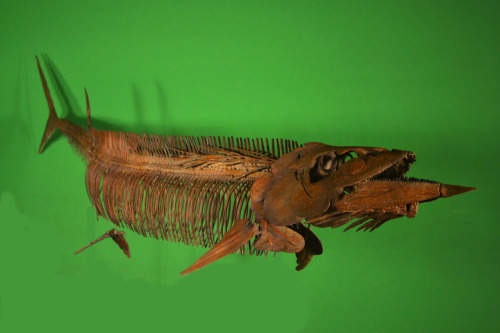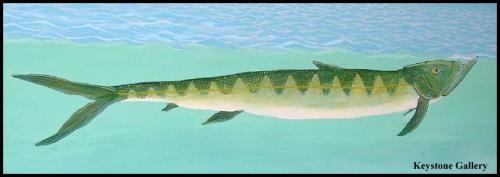Saurodon - a sword eel Mounted reconstruction on display at the Rocky Mountain Dinosaur Resource Cen
Saurodon - a sword eel Mounted reconstruction on display at the Rocky Mountain Dinosaur Resource Center, Woodland Park, Colorado Reconstruction by Charles Bonner When: Cretaceous (~ 89 - 83 million years ago) Where: North America What: Saurodon is one of the large fish which swam though the Cretaceous Seaway, the marine waters that covered much of North America during the late Mesozoic. This particular species was ‘only’ about 8.5 feet (~2.6 meters) long, with a relatively skinny body and large pointed lower jaw. These features are what gives the family Saurodontidae the nick-name 'sword eels’. The Saurodontidae fall into the later group Ichthyodectidae, a completely extinct clade that contains some of the largest fish on record. Today the living relatives of these gigantic fishes are in the clade Osteoglossomorpha and are some of the largest bony fish that swim though today’s waters. This was not a very specious group - there are only three described species - but they have been known to science for almost two-hundred years. The first Saurodontidaewas named in 1824 by Richard Harlan (the discover of Harlan’s ground sloth) - but was misidentified as the jaw of an extinct marine reptile. This was corrected only six years later when the first Saurodon specimen was found, and it was clear that the fragmentary specimen which was previously named belonged to a large fish, not a marine reptile. The use of the long lower jaw in Saurodon and its kin is not well understood, but it has been hypothesized that perhaps these predatory fish dug prey out from the deep muds at the bottom of the seaway. -- source link
Tumblr Blog : dailyfossil.tumblr.com
#marine#mesozoic#cretaceous#aquatic#north america#paleontology#geology#fossil#biology#predator#giant fish#ichthyology#actinopterygii#science

